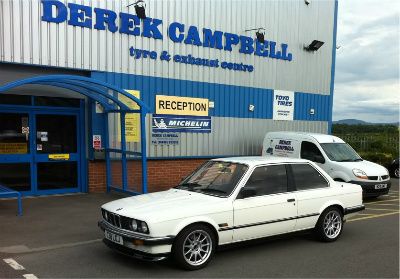Haven't had much of a chance to work on the car lately, but, by way of a
small update to the thread I've routed out the last of the pic's for the
engine prep section.
One of the final items on the list to check were the valve springs...........

both the outer and smaller inner springs first had a quick check to make sure their
free standing heights were all equal.......


tolerance I'm using is 1.5mm, so, any spring thats over 1.5mm shorter
than it's brothers and sisters bites the bullet.
happy that none of the springs were deformed or "squashed" from previous use
the next check was to ensure each one was straight.........

tolerance this time around was 4mm, any spring displaying a drunken lean of
more than 4mm gets shown the door.
Before finally the poundage of each spring is checked using this little gauge......

Each spring is placed into the screw press and using the dial gauge each
one can be compressed the same distance while the force it takes to do
so can be read off the little gauge.........


The idea behind the check is to highlight any weak springs which may struggle to
control the valve when the engine rev's start to rise, and having seen in the last
section how close the valves run to the tops of the pistons the last thing you want is a rebel
valve doing it's own thing as the piston hurtles up the cylinder at warp
speed trying it's best to make shite of it.
Schrick list pressures in their catalogue so you can check each springs pressure at it's installed
height and at it's fully opened height (valve fully opened, spring compressed) to make sure they're
on the money.
However, when testing other makes of springs or even the standard BMW valve
springs it can be hard to track down this info and in this is the case each spring is just compressed to
it's installed height and it's fully opened height and the pressures are noted and all are checked to see
if they are within 10 percent of each other which is usually good enough to show up a weak
spring.
After this was done it was on to the coma inducing task of checking
valve spring installed heights.
So,
whats the deal here,
nobody asks.
Looking at the picture below you can see all the valve's in place and
and the springs pulling the valves tightly closed into their seats..........

The springs need to be pulling the valves closed into their seats just the right
amount. The smart folk that design valve springs do so in such a way that when the
valve is installed in the head, and it's spring is fitted, the valve spring is compressed
just enough to hold the valve shut with the right amount of force.
This is all bloody marvellous when the engine leaves the factory, but now we've had
a chance to screw around with things by cutting the valve seats and fitting aftermarket
valve springs we were going to have to check the new valves were going to be pulled shut
again just the right amount.
To do this we were going to have to measure the "valve spring installed heights". And
hopefully the diagram below should help to show what this measurement is........

As you can see above the valve spring is trapped between the lower and upper
valve spring retainers. The distance between these two retainers is the valve spring
installed height and Schrick kindly list what this measurement should be in their catalogue.
So next we need a way to measure what the installed heights were on my valves so
we can check it against this figure and below you can see what we use.
It's called a valve spring micrometers............

Basically the little tool is inserted instead of the valve spring and you rotate the
two halfs of the tool to extend it. When the tool is extended as much as the valve
spring retainers will allow you read off the little increments on the side to see
what the distance is between the top and bottom retainers...........

Unfortunately due to the nature of the design of the S14 cylinder head and the
shape of the retainers I'm using the little tool took some serious modifying to
fit into place and do it's job right. After a little bashing and much swearing
it worked and what it showed was that my installed heights were too large
as things stood which would mean the valve springs wouldn't be squashed
enough at rest to hold the valve shut with the right amount of pressure.
Thankfully the cure is rather straight forward. Some valve spring shims,
which are available in a variety of different thickness's, were purchased
and fitted below the bottom retainers to return the installed heights to what
they should be.

















































































































































































